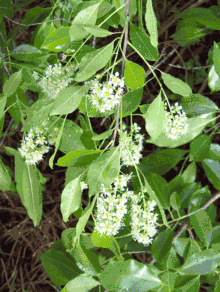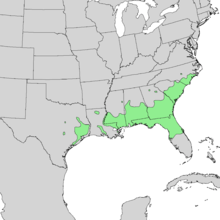Prunus caroliniana
| Prunus caroliniana | |
|---|---|
 | |
| Scientific classification | |
| Kingdom: | Plantae |
| Clade: | Angiosperms |
| Clade: | Eudicots |
| Clade: | Rosids |
| Order: | Rosales |
| Family: | Rosaceae |
| Genus: | Prunus |
| Species: | P. caroliniana |
| Binomial name | |
| Prunus caroliniana | |
 | |
| Natural range of Prunus caroliniana | |
| Synonyms[1][2] | |
| |
Prunus caroliniana, known as the Carolina laurelcherry,[3] Carolina cherry laurel, cherry laurel, or Carolina cherry, is a small evergreen flowering tree native to the lowlands of Southeastern United States, from North Carolina south to Florida and westward to central Texas.[4][5][6] The species has also escaped into the wild in a few places in California.[7]
Prunus caroliniana is not to be confused with its European relative Prunus laurocerasus, which is also called Cherry Laurel, though mainly known as English Laurel in the U.S.
Description
Prunus caroliniana is a small to medium-sized evergreen tree which grows to about 5–13 meters (16–43 ft) tall, with a spread of about 6–9 meters (20–30 ft). The leaves are dark green, alternate, shiny, leathery, elliptic to oblanceolate, 5–12 cm (2–4.5 in) long, usually with an entire (smooth) margin, but occasionally serrulate (having subtle serrations), and with cuneate bases. Reproductively mature trees have entire margins, whereas immature ones often have subtle serrations.[8] The twigs are red to grayish brown, slender, and glabrous.[9]
Fragrant white to cream-colored flowers are produced in racemes (stalked bunches) 5–8 cm (2–3 in) long in the late winter to early spring.[4] The fruits are tiny black cherries about 1 cm (0.5 in) in diameter, which persist through winter and are primarily consumed by birds (February - April).[8]
Characteristics
The leaves and branches contain high amounts of cyanogenic glycosides that break down into hydrogen cyanide when damaged, making it a potential toxic hazard to grazing livestock and children.[4] Due to this, it is considered highly deer-resistant.[8] When crushed, its leaves and green twigs emit a fragrance described as resembling maraschino cherries[10] or almond extract.
Cultivation
Prunus caroliniana has long been an ornamental tree and landscape hedge shrub in gardens in many parts of the Atlantic states of the United States. The tree is considered hardy in USDA zones 7B through 10A. It is often used in areas where a tough broadleaved evergreen tree is needed of modest size. It prefers full sun and well-drained, acidic soil, often developing chlorosis if grown in overly alkaline soil. It is known to grow to elevations of 152 m (499 ft).[11]
Cultivars
Cultivated varieties include:
- Prunus caroliniana 'Compacta' grows to about half the usual height and width of the species.
- Prunus caroliniana 'Cherry Ruffles' has wavy/ruffled leaf margins.
References
- ↑ "The Plant List: A Working List of All Plant Species". Retrieved January 27, 2014.
- ↑ Tropicos, Prunus caroliniana (Mill.) Aiton
- ↑ "Prunus caroliniana". Natural Resources Conservation Service PLANTS Database. USDA. Retrieved 14 October 2015.
- 1 2 3 "Prunus caroliniana". Floridata.
- ↑ "Prunus caroliniana". Germplasm Resources Information Network (GRIN). Agricultural Research Service (ARS), United States Department of Agriculture (USDA). Retrieved 21 December 2017.
- ↑ Biota of North America Program 2014 county distribution map
- ↑ Calflora taxon report, University of California, Prunus caroliniana Ait. Carolina laurelcherry
- 1 2 3 "Prunus caroliniana". Native Plant Database. Lady Bird Johnson Wildflower Center.
- ↑ Allen, Charles M.; Dawn Allen Newman; Harry H. Winters (2002). Trees, Shrubs, And Woody Vines Of Louisiana. Los Angeles: Allen's Nature Ventures. p. 192. ISBN 0-9718625-0-8.
- ↑ "Prunus caroliniana: Cherry-Laurel". University of Florida.
- ↑ Little, Elbert L.; Alfred A. Knopf (1986). The Audubon Society Field Guide To North American Trees (5th ed.). New York, NY. p. 497. ISBN 0-394-50760-6.
External links
| Wikimedia Commons has media related to Prunus caroliniana. |
- Prunus carolina in the Native Plant Identification Network
- Prunus caroliniana in the CalPhotos Photo Database, University of California, Berkeley